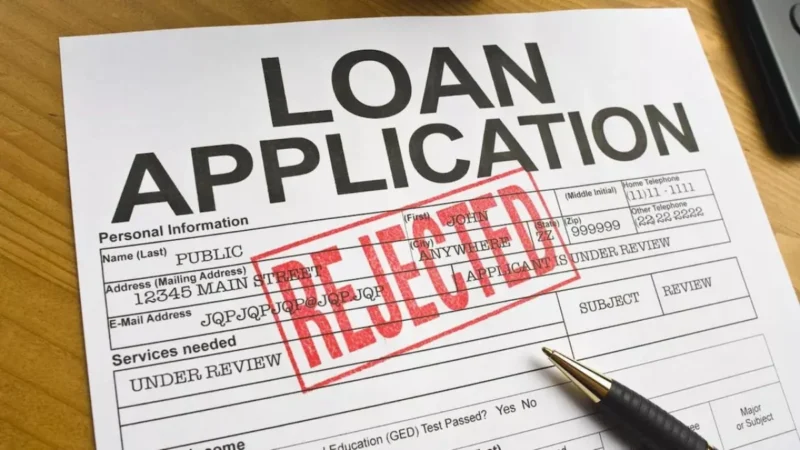Introduction
You painstakingly filled out your loan application. You cross-checked your documents. You felt confident. Then you got the dreaded: “Declined.”
Why? Because there’s often a small but fatal mistake you didn’t see—and lenders see it. In this post, we’ll dig deep into the most common missteps that lead to rejection. You’ll also get actionable fixes, real examples, and a path forward.
What Really Happens Behind the Scenes
Understanding why lenders say “no” helps you see how a single misstep can outweigh everything else.
- Lenders rely on scoring models and algorithms to evaluate risk, rather than subjective judgments.
- A rejection often points to one or two critical red flags, not your whole profile failing.
- In many jurisdictions, you’re legally entitled to know the main reasons for denial (an adverse action notice)—use that feedback.
- Sometimes you’re rejected because of lender-specific policies (residency, loan purpose, sector) — even a strong applicant can be filtered out early.
Let’s walk through the biggest pitfalls so you won’t fall prey to them.
Common Mistakes That Lead to Loan Rejection (and How to Repair Them)
Here are the most frequent errors, why they matter so much, and clear steps you can take to fix them.
1. Weak or Damaged Credit History
Why it disqualifies you
Your credit history is the most direct signal of your borrowing risk. Missed payments, defaults, high balances—all leave marks. Lenders treat historical behavior as a predictor of future reliability.
Also, errors are surprisingly common in credit reports—one out of four consumers finds at least one error.
How to rehabilitate your credit profile
- Get your credit report from the relevant bureau, inspect it carefully.
- Dispute any incorrect entries immediately.
- Maintain consistent on-time payments—payment history is ~35% of your credit score.
- Keep your credit utilization (how much of your available credit you use) low (ideally under 30%).
- Gradually diversify your credit (installment + revolving), but don’t overextend.
- Don’t close old accounts arbitrarily—length of history helps your score.
2. High Debt-to-Income Ratio (DTI)
Why DTI is a red flag
DTI measures how much of your income is already committed to debt payments. If too much is tied up, the lender doubts you can responsibly take on another obligation. Many lenders aim for DTI under 43%.
Even good income won’t save you if your DTI is excessive—it suggests little financial breathing room.
How to bring down your DTI
- Focus on paying down high-interest debts first (credit cards, personal loans).
- Avoid taking on new debt just before applying.
- Temporarily cut discretionary spending to free cash for debt reduction.
- Try to boost income (side gigs, overtime) before applying.
- If possible, request a lower loan amount that your cash flow can support.
3. Insufficient or Unsteady Income
Why income matters beyond numbers
Lenders don’t just care about how much you make—they care how steady it is. Unpredictable or irregular income (freelancers, gig economy, seasonal work) may count against you.
They’ll also scrutinize job stability, employment duration, gaps, and whether your income can be verified.
If your income appears too low relative to the loan amount, the lender may simply conclude you can’t service the debt.
How to strengthen your income presentation
- Collect and include pay stubs, tax returns, bank statements, contracts.
- Show multiple income streams (side business, passive income) if legitimate.
- Wait until you’ve been employed in your current role for a solid period (3–6 months or more).
- Use a co-signer with stronger income if needed.
- Avoid inflating or projecting income without documentation.
4. Multiple Hard Credit Inquiries / Multiple Loan Applications
Why lenders see this as risky
Each time you submit a loan or credit application, many lenders perform a hard inquiry. Too many in a short window signal desperation—or that your profile isn’t strong enough elsewhere.
Even if your score is good, multiple inquiries can drag it down slightly. Some lenders will treat them as warning signs.
How to avoid this trap
- Use prequalification tools (which rely on soft inquiries).
- Do your research first—only apply where you have a realistic chance.
- Space out applications over time (don’t fire off five in one week).
- If rejected, pause, strengthen your profile, then reapply.
5. Errors, Omissions, or Unverifiable Details in Application
Why a small mistake can kill you
Lenders often drop applications if verification fails. Typos, missing documents, inconsistent data—all may hide deeper problems.
For example:
- Wrong national ID, social security, or tax number
- Mismatched addresses between documents
- Using estimated figures instead of actuals
- Missing signatures or supporting proofs (bank statements, residence proof)
- Failing to respond to document requests in time
Even a minor mismatch can break the verification chain.
How to bulletproof your application
- Proofread your entire packet (or have someone else do it).
- Use official documents—not “estimates.”
- Submit clean, legible scans or originals.
- Track and respond promptly to any requests from the lender.
- Keep consistency across all forms and documents.
6. Requesting Too Large a Loan Amount
Why overreaching backfires
You may qualify for a large sum, but asking for too much relative to your income and liabilities makes your profile look risky. Lenders prefer conservative requests they believe you can reliably service.
How to calibrate your request
- Use a loan calculator to estimate what your monthly burden would be.
- Request a smaller amount initially if possible.
- Compare with what lenders publicly cap or approve.
- Show that your repayment plan is sustainable, not stretching.
7. Thin Credit File / Few Historical Credit Lines
Why “too little” credit is a red flag
No credit history = no signal. Lenders prefer profiles they can reliably analyze. Without data points, your risk is unknown.
How to build a credit track record
- Use secured or starter credit cards and make regular payments.
- Take small installment loans and repay.
- Become an authorized user on someone’s credit card with strong history (if trustworthy).
- Maintain accounts over time and avoid closing them prematurely.
8. Weak, Inadequate, or Unaccepted Collateral (for Secured Loans)
Why weak collateral can kill your application
Secured loans rely on collateral as a safety net. If your collateral is undervalued, in dispute, or not accepted by the lender, your application might be rejected.
How to strengthen collateral appeal
- Use high-quality, well-documented assets (property, vehicle, equipment).
- Clean up titles, legal ownership proof, and valuation reports.
- Offer multiple forms of collateral when possible.
- Supplement with personal guarantees or co-signers if needed.
9. Business Cash Flow Volatility or Weak Financials (for Business Loans)
Why lenders worry about unstable business revenue
Your personal credit is often only part of the story. For business loans, lenders examine your enterprise’s cash flow, revenue consistency, margins, and client diversity.
Rejection factors include:
- Revenue that swings dramatically (seasonal business).
- Thin or negative cash flow.
- Heavy reliance on one or two clients.
- Lack of credible financial statements or projections.
- No buffer or reserve in lean periods.
How to make your business case stronger
- Show multi-year trend lines, not just one good year.
- Maintain cash reserves or buffer accounts.
- Use contracts, purchase orders, letters of intent to validate future revenue.
- Provide audited or verified financial statements.
- Diversify client base.
- Present a solid business plan forecasting growth with realistic assumptions.
10. Ignoring Lender’s Unique Rules & Filters
Why this surprises many applicants
Even a strong financial profile may be rejected due to non-financial filters. Every lender has preferences and exclusions—such as location, business sector, age, loan purpose, or collateral type.
For instance:
- A lender might exclude certain industries for risk reasons.
- Some may require you to live in specific jurisdictions.
- They may demand minimum job tenure or history in business.
- The property or collateral type must meet their standards (especially for mortgages).
How to detect and satisfy these filters
- Read eligibility criteria carefully (often in fine print).
- Pre-screen with the lender or an officer.
- Create a checklist with both financial and non-financial requirements.
- Tailor your application to the lender’s preferences.
What to Do Immediately After Rejection
Rejection stings—but it’s also your guide. Here’s how to recover smartly.
- Get the reasons in writing
The adverse action notice (or equivalent) often reveals the main rejection factors. - Check your credit report deeply
Look for errors, stale negative items, or fraud. Dispute and correct what you find. - Match your profile against what they flagged
Did they cite DTI? Credit score? Collateral? Focus there first. - Address the weak point(s) intentionally
Don’t spread energy too thin. Fix credit, reduce debt, or stabilize income depending on the biggest gap. - Wait before reapplying
Give it 90–180 days (or whatever makes sense in your market) so improvements register. - Consider alternative lenders or loan structures
Microfinance, peer-to-peer, or secured lines may have more flexibility. - When reapplying, bring stronger proof
Show your progress: paid-down debts, improved credit ratings, better documentation, additional collateral.
Show, Don’t Just Tell — Case Examples
Here are real (but anonymized) scenarios to help you connect the dots.
Example 1: Overzealous inquiry spree
Samuel applied to five lenders over two weeks. Each did a hard credit pull. Despite meeting basic thresholds, the flurry of inquiries triggered rejection across the board.
Lesson: Be selective. Use soft prequalifiers. Avoid drowning your credit profile in fresh inquiries.
Example 2: High income, high burden
Fatima earned well, but her existing debts consumed much of her salary. She asked for a large loan amount. The lender saw her DTI was dangerously high, so the application was denied.
Lesson: Income is meaningless without context. Make sure your debt burden doesn’t eclipse your capacity.
Example 3: Seasonal business trouble
Samuel runs an event planning firm whose revenue surges during holiday seasons and plunges off-peak. The lender reviewed off-peak months and saw low or negative cash flow—insufficient assurance for consistent repayment.
Lesson: Show buffers or use conservative multi-year averages. Don’t rely only on high-season numbers.
Example 4: An innocent typo kills it
Ebun had well-structured finances and good credit. But in her application, she typed “01234” instead of “01324” for her national ID. The lender’s systems flagged a mismatch and dropped the file.
Lesson: Accuracy matters as much as strength.
Comparison Table at a Glance
| Mistake | Why It Rings Alarm Bells | Quick Fix | Strategy Over Time |
|---|---|---|---|
| Weak credit or errors | Weak repayment history or wrong data | Dispute errors, pay bills on time | Build diverse, long-running credit lines |
| High DTI | Signals cash flow is oversubscribed | Pay down debts, trim expenses | Maintain DTI well below 40–43% |
| Unstable / low income | Lender fears inability to pay | Provide full documentation, wait longer | Build income consistency or diversify income |
| Multiple hard inquiries | Screams “desperation” | Pause new applications | Be selective, use soft qualifying |
| Application errors / missing docs | Verification breaks down | Proofread, include all docs | Create and reuse clean application templates |
| Overreaching amount | Loan seems unsustainable | Downsize your ask | Gradually scale borrowing |
| Thin credit file | Insufficient data to judge risk | Start with small credit lines | Grow history gradually |
| Weak collateral | Lender’s fallback is weak | Use high-quality assets / guarantees | Build or own assets lenders prefer |
| Volatile business cash flow | Repayment risk unclear | Show buffer, contracts, consistent revenue | Build diversified, stable business |
| Ignoring lender rules | Auto filter-out for nonfinancial reasons | Pre-check eligibility | Match your profile to lender policies |
Final Thoughts & Next Steps
Rejection is not a verdict—it’s feedback. Often a single glaring issue outweighs several strengths. The aim is to remove that one red flag.
Your action plan now:
- Demand the reasons (if available)
- Deep dive into credit report and fix errors
- Calculate DTI and reduce debt
- Stabilize income evidence
- Proof every detail of your application
- Choose a loan amount aligned with your capacity
- Wait, improve, then reapply with evidence







